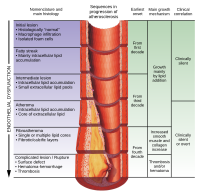
Photo from wikipedia
OBJECTIVE To describe a modified technique for permanent translocation of the common carotid artery (CCA) to a subcutaneous position in standing horses. STUDY DESIGN Experimental study. ANIMALS Healthy adult Standardbred… Click to show full abstract
OBJECTIVE To describe a modified technique for permanent translocation of the common carotid artery (CCA) to a subcutaneous position in standing horses. STUDY DESIGN Experimental study. ANIMALS Healthy adult Standardbred and Warmblood horses (n = 8). METHODS Surgery was performed with the horses standing under sedation and with local anesthesia. A combination of previously described techniques was used modifying the approach and closure of the incision. The right CCA was approached through a linear skin incision dorsal and parallel to the jugular vein and through the brachiocephalicus and omohyoideus muscles. The artery was dissected free of its sheath and elevated to the skin incision with Penrose drains. The brachiocephalicus muscle was sutured in two layers underneath the artery leaving it in a subcutaneous position. The horses were allowed to heal for 3 weeks prior to catheterization of the artery. RESULTS The transposed CCA was successfully used for repeated catheterization in six of eight horses for a period of 10 weeks. None of the horses had intraoperative complications. Two horses developed mild peri-incisional edema that resolved spontaneously. Right-sided laryngeal hemiplegia was observed endoscopically in two horses postoperatively. Two horses developed complications (surgical site infection and excessive periarterial fibrosis) that compromised the patency of the CCA and precluded catheterization. CONCLUSION Permanent translocation of the CCA in standing horses was successful in six out of eight horses. Upper airway endoscopy postoperatively may be warranted as laryngeal hemiplegia may ensue.
Journal Title: Veterinary Surgery
Year Published: 2017
Link to full text (if available)
Share on Social Media: Sign Up to like & get
recommendations!